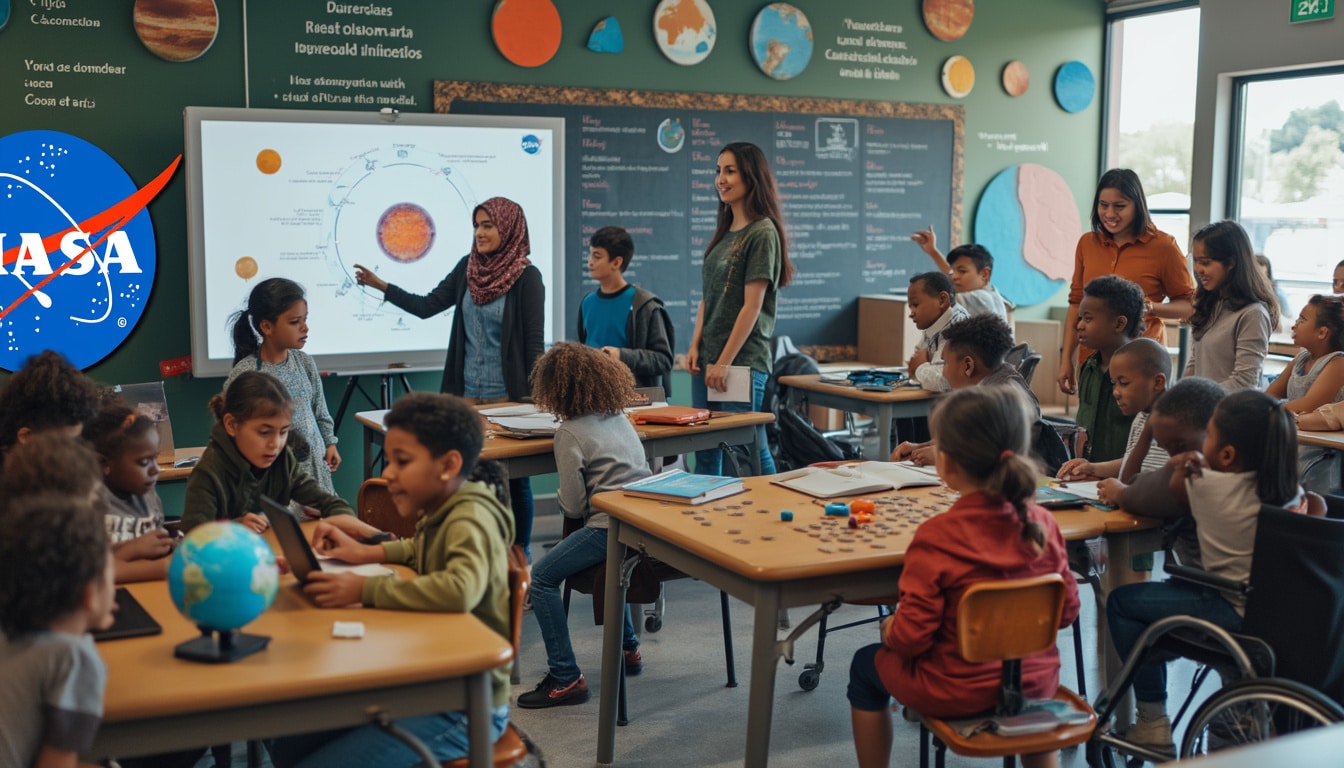The recent withdrawal of a vital grant by NASA aimed at promoting diversity, equity, and inclusion in STEM fields is creating waves in the educational landscape. This initiative was specifically designed for Kutztown University, which had been selected to participate in a program offering students unique opportunities to engage with NASA’s Planetary Science Division. The abrupt cancellation of funding, driven largely by political decisions, particularly by the Trump administration, has left students and faculty in a state of uncertainty about their futures in the sciences, especially those from underrepresented backgrounds. The Here to Observe program was not only a chance for hands-on experience but also a pathway to encourage participation in STEM careers among historically marginalized groups. With significant impacts to education and future opportunities, many are questioning the implications of such budgetary decisions.
The Impact of Grant Withdrawals on STEM Education
The recent decision to withdraw funding from Kutztown University’s Here to Observe program reflects a larger trend affecting STEM initiatives across the country. This program served as a lifeline for numerous undergraduate students aspiring to delve into the realms of science, technology, engineering, and mathematics. The funding of $375,000 was geared towards enhancing the educational experiences of underrepresented groups, providing them the necessary tools to pursue STEM careers. Yet, with the dissolution of this grant, the future of many aspiring scientists now hangs in the balance.

Understanding the Here to Observe Program
The Here to Observe program was a collaborative effort aiming to bridge the gap between academic learning and practical experience in the field of planetary science. Initiated as a pilot in 2021, it quickly garnered recognition for its focus on inclusivity. Students had the rare opportunity to connect with experienced scientists, engage in hands-on projects, and even participate in mission discussions related to Mars exploration and the Perseverance Rover. Such exposure is not merely educational; it instills a sense of belonging and encourages persistence in fields traditionally dominated by underrepresented demographics. The emphasis was laid not just on academic performance but on fostering a community where everyone could thrive and contribute meaningfully.
The Political Climate and Its Ramifications
Political influences often seep into educational funding and priorities. The Trump administration’s clear stance against programs highlighting diversity, equity, and inclusion (DEI) has serious consequences for initiatives like Here to Observe. Despite its success and potential, the program was deemed incompatible with new federal budgetary priorities. As reported, funding for such programs has been cut, thwarting efforts to cultivate a diverse scientific community. This raises questions about the long-term implications for STEM fields that greatly benefit from fresh perspectives and a variety of experiences. The students from Kutztown University, eagerly engaged in their work, now face an uncertain academic landscape due to these cuts.
Experiences of Kutztown University Students
The abrupt cancellation of the grant has left many Kutztown University students feeling despondent. They were set to gain invaluable experiences that are crucial for their professional development. For many, participating in the Here to Observe program was not simply a checkbox on their educational journey; it represented a unique opportunity to interact with NASA mentors, receive guidance on career paths, and immerse themselves in the scientific community. One student expressed their concerns about missing opportunities that could have been immensely beneficial in years to come. This despair echoes sentiments across the nation as students grapple with the anxiety of navigating a constrained educational landscape.
Unpacking the Importance of Diversity in STEM
Diversity, equity, and inclusion are not just buzzwords but crucial components to advancing knowledge and innovation in STEM fields. As highlighted by experts, a diverse scientific workforce propels innovation and problem-solving capabilities. When different backgrounds and perspectives converge, interdisciplinary collaboration flourishes, leading to groundbreaking discoveries. However, the current trend of slashing funding for DEI programs stunts this growth. Many institutions are beginning to recognize that this inclusivity is not about taking opportunities away from one group to give to another; it is about expanding the realm of possibilities for everyone involved. This approach enhances the educational fabric and science as a whole.

Historical Context of DEI in Education
The roots of diversity initiatives in education run deep, tracing back to the systemic barriers that have long prevented marginalized groups from accessing quality education and professional opportunities. Historically, institutions of higher education were often not open to women, people of color, and low-income individuals. Therefore, efforts aimed at promoting DEI are not merely a contemporary trend; they are part of a broader movement to rectify historical injustices and create equitable opportunities. The Here to Observe program aimed to disrupt the status quo, but now, with funding cuts, aspiring future leaders in STEM face uncertain pathways ahead.
The Potential of Future Programs
While the withdrawal of this grant is undoubtedly a setback, it is essential to maintain momentum in advocacy for programs that support diversity in STEM. Increased awareness and engagement with both educational institutions and funding agencies can cultivate an environment where such initiatives flourish rather than diminish. Kutztown University’s commitment to educating students and promoting participation in STEM must be bolstered by essential funding and support structures. The STEM community is larger than any singular program, and its success hinges on collaborative efforts from various stakeholders to push for equity and ensure that no student is left behind.
Challenges and Solutions in Pursuing STEM Diversity
The landscape of STEM education is fraught with challenges, particularly concerning funding for initiatives aimed at fostering diversity. A robust approach to addressing these challenges involves understanding the systemic issues at play, as well as viewing these obstacles as opportunities for innovative solutions. Navigating government funding can be complex, and advocacy for consistent support for programs focusing on diversity, equity, and inclusion remains paramount for students hoping to advance their education and careers.
Organizational Dynamics and Advocacy
Organizations and institutional actors play critical roles in shaping the funding landscape for STEM education. Collaborative efforts can amplify voices advocating for funding diversity initiatives. For instance, experiences of underrepresented students can be documented and shared to highlight the necessity of ongoing support. Moreover, building partnerships between universities and industries can create bridges for funding, offer mentorship, and allow students to gain real-world experiences. These pathways must be leveraged to ensure that marginalized students have a seat at the STEM table.
Engaging with Local Communities
Engaging local communities in STEM initiatives not only enhances education but also connects students with valuable resources. Such connections can provide students with opportunities for internships, job shadowing, and networking that are crucial for hands-on experience. Establishing outreach programs focused on underrepresented groups can foster relationships with local industry leaders and organizations, paving the way for scholarships and funding for programs like Here to Observe. The need for STEM skills will only continue to grow, and building a collaborative environment ensures that all talent is harnessed effectively.
Vision for the Future of Kutztown’s STEM Programs
The future of Kutztown University’s STEM programs is dependent on strong advocacy, innovative partnerships, and a commitment to prioritizing diversity, equity, and inclusion. University officials must explore alternative funding sources and channels to promote successful reintegration of the Here to Observe program and similar initiatives. At a time when the value of diverse perspectives in science is more apparent than ever, securing funding to enhance these educational experiences remains an essential endeavor.
Conclusion: Finding Hope Amidst Uncertainty
As students and faculty at Kutztown University reflect on the recent withdrawal of the NASA grant, it is clear that the importance of advancing diversity, equity, and inclusion in STEM education remains pivotal. The conversations ignited by the Here to Observe program underscore the need for ongoing dialogue that spans political and institutional barriers as the stakes have never been higher. By addressing these complexities, successes can be cultivated, fostering a more inclusive STEM landscape for future generations. While challenges loom ahead, the resilience of students and advocates promises a more equitable future in science and technology.




Leave a Reply